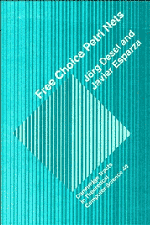Book contents
- Frontmatter
- Contents
- Preface
- 1 Introduction
- 2 Analysis techniques for Petri nets
- 3 S-systems and T-systems
- 4 Liveness in free-choice systems
- 5 The Coverability Theorems
- 6 The Rank Theorem
- 7 Reduction and synthesis
- 8 Home markings
- 9 Reachability and shortest sequences
- 10 Generalizations
- References
- Index
- List of symbols
- List of main results
1 - Introduction
Published online by Cambridge University Press: 21 October 2009
- Frontmatter
- Contents
- Preface
- 1 Introduction
- 2 Analysis techniques for Petri nets
- 3 S-systems and T-systems
- 4 Liveness in free-choice systems
- 5 The Coverability Theorems
- 6 The Rank Theorem
- 7 Reduction and synthesis
- 8 Home markings
- 9 Reachability and shortest sequences
- 10 Generalizations
- References
- Index
- List of symbols
- List of main results
Summary
Petri nets are one of the most popular formal models of concurrent systems, used by both theoreticians and practitioners. The latest compilation of the scientific literature related to Petri nets, dating from 1991, contains 4099 entries, which belong to such different areas of research as databases, computer architecture, semantics of programming languages, artificial intelligence, software engineering and complexity theory. There are also several introductory texts to the theory and applications of Petri nets (see the bibliographic notes).
The problem of how to analyze Petri nets – i.e., given a Petri net and a property, how to decide if the Petri net satisfies it or not – has been intensely studied since the early seventies. The results of this research point out a very clear trade-off between expressive power and analyzability. Even though most interesting properties are decidable for arbitrary Petri nets, the decision algorithms are extremely inefficient. In this situation it is important to explore the analyzability border, i.e., to identify a class of Petri nets, as large as possible, for which strong theoretical results and efficient analysis algorithms exist.
It is now accepted that this border can be drawn very close to the class of free-choice Petri nets. Eike Best coined the term ‘free-choice hiatus’ in 1986 to express that, whereas there exists a rich and elegant theory for free-choice Petri nets, few of its results can be extended to larger classes. Since 1986, further developments have deepened this hiatus, and reinforced its relevance in Petri net theory.
- Type
- Chapter
- Information
- Free Choice Petri Nets , pp. 1 - 12Publisher: Cambridge University PressPrint publication year: 1995



